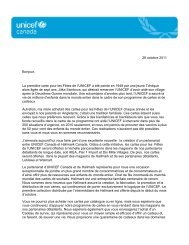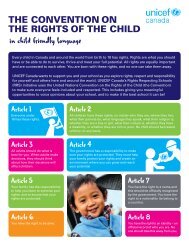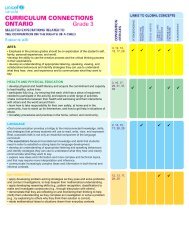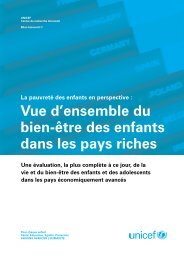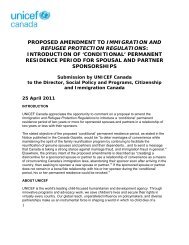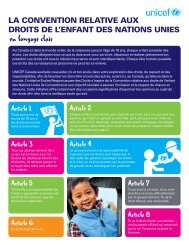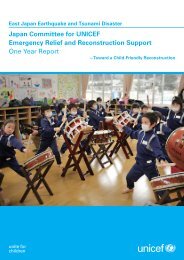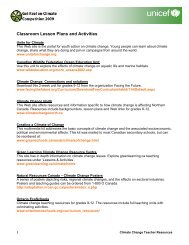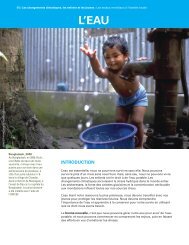Aboriginal children's health: Leaving no child ... - UNICEF Canada
Aboriginal children's health: Leaving no child ... - UNICEF Canada
Aboriginal children's health: Leaving no child ... - UNICEF Canada
You also want an ePaper? Increase the reach of your titles
YUMPU automatically turns print PDFs into web optimized ePapers that Google loves.
42 URBAN ABORIGINAL CHILDREN IN CANADA:<br />
BUILDING A SOLID FOUNDATION FOR PROSPERITY AND CHANGE<br />
BY THE NUMBERS<br />
54<br />
The percentage of First<br />
Nations <strong>child</strong>ren off-reserve<br />
rated as being in excellent<br />
<strong>health</strong>.<br />
58<br />
The percentage of all<br />
<strong>child</strong>ren in <strong>Canada</strong> rated as<br />
being in excellent <strong>health</strong>.<br />
The question must be asked again: How exactly does a 17-year-old, with few<br />
employable skills, raise a <strong>child</strong>? Coming from a pedigree of strong-willed women<br />
and those who survived cultural ge<strong>no</strong>cide, she is <strong>no</strong> stranger to struggle and the<br />
historical subjugation of her spirit. Experiencing conditions that are highly<br />
inequitable compared to the rest of <strong>no</strong>n-<strong>Aboriginal</strong> Canadians is her reality and the<br />
daily struggle faced by many urban <strong>Aboriginal</strong> <strong>child</strong>ren. Oftentimes, <strong>child</strong>ren share<br />
a room with other family members, regularly access soup kitchens, and sometimes<br />
receive clothes only when donations are available at the local church or Friendship<br />
Centre. Poverty and substandard housing have been linked to higher rates of <strong>child</strong><br />
apprehension into the welfare system. 16 This has led to the placement of many<br />
<strong>Aboriginal</strong> <strong>child</strong>ren into foster homes with <strong>no</strong>n-<strong>Aboriginal</strong> families, leaving them<br />
cut off and disconnected from their roots and culture. While well-intentioned,<br />
many of these <strong>no</strong>n-<strong>Aboriginal</strong> foster families have little sensitivity to <strong>Aboriginal</strong><br />
issues or their unique cultural intricacies.<br />
While our focus has been to shed light on the living conditions of urban <strong>Aboriginal</strong><br />
families and their influence on <strong>child</strong>ren’s <strong>health</strong>, much can be said about the<br />
<strong>Aboriginal</strong> strength of spirit and its ability to triumph over a litany of obstacles and<br />
challenges. Many urban <strong>Aboriginal</strong> people today enjoy a deep-rooted sense of<br />
family, community, culture and connection to their homes. This dedication to<br />
<strong>child</strong>ren and families, grounded in traditional values and customs, is a source of<br />
strength and resiliency that is integral to improving the lives of urban <strong>Aboriginal</strong><br />
<strong>child</strong>ren. By preserving and enriching <strong>Aboriginal</strong> culture, language, teachings and<br />
customs, <strong>Aboriginal</strong> Friendship Centres across <strong>Canada</strong> are a key element of<br />
this resiliency.<br />
Guèvremont, Anne, and Kohen, Dafna, ‘Inuit<br />
<strong><strong>child</strong>ren's</strong> <strong>health</strong>: A report using the 2001<br />
<strong>Aboriginal</strong> Peoples Survey (Children and Youth<br />
Component)’, Statistics <strong>Canada</strong>, Ottawa, 28<br />
September 2007, www.statcan.gc.ca/pub/89-627-<br />
x/89-627-x2007003-eng.htm.<br />
FRIENDSHIP CENTRES: MAKING URBAN<br />
CONNECTIONS<br />
Language and customs are integral to maintaining a sense of identity and pride, a<br />
key element in the <strong>health</strong> and well-being of <strong>Aboriginal</strong> peoples. For many urban<br />
<strong>Aboriginal</strong> youth and <strong>child</strong>ren, the <strong>Aboriginal</strong> Friendship Centre Program provides a<br />
key connection to <strong>Aboriginal</strong> culture, spirituality and communal nature, and a key<br />
foundation to improving their <strong>health</strong> and well-being. <strong>Aboriginal</strong> Friendship Centres<br />
“support and assist urban <strong>Aboriginal</strong> youth across <strong>Canada</strong> in enhancing their<br />
eco<strong>no</strong>mic, social, cultural and personal prospects.” 17 Their doors are open to<br />
everyone.<br />
Operating in more than 117 cities across <strong>Canada</strong>, 18 Friendship Centres are the<br />
country’s most significant off-reserve <strong>Aboriginal</strong> service infrastructure. They offer a<br />
“range of cultural, social, and recreational programming that strengthens<br />
<strong>Aboriginal</strong> families and communities, and empowers individuals to reach their<br />
goals.” 19 On any given day in a Friendship Centre, people enjoy free meals, receive<br />
clothing, obtain training, look for employment and participate in cultural events,<br />
just to name a few activities. The centres play a role in bettering the lives of many<br />
urban <strong>Aboriginal</strong> families. For <strong>child</strong>ren, some of the centres offer summer camps,<br />
play groups, and the opportunity to make traditional dance regalia and crafts. A<br />
range of programmes and services is offered to women, including programmes<br />
targeted at young mothers, victims of abuse and survivors of trauma. In essence,




